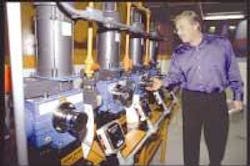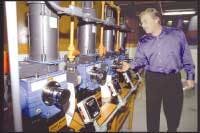Upgrading Chemical Feed, Mixing Improves Coagulation Efficiency
By Jeff Musinski
When the Waukegan, Ill., Water Department decided to upgrade chemical feed at its surface water filtration plant, management knew that durability, accuracy and automation were essential. Today, fully integrated, high performance chemical mixing and feed systems are allowing the plant to achieve faster settling and lower alum use while producing higher finished water quality.
The Waukegan Water Filtration Plant, built in 1928, is a conventional surface water treatment plant which includes chemical pretreatment, flocculation, sedimentation, filtration and disinfection. During the past several years, Waukegan's 300 miles of mains have carried more than 3.5 billion gallons of water throughout the city and to neighboring communities. While the present filtering capacity at the plant is 18 mgd, it has a short period run capacity of 24 mgd.
Many of the plant's chemical feed systems were installed in the mid 1960s. These included outdated feed devices that made it difficult to determine when coagulant was being underfed, resulting in higher finished water turbidity, or overfed, which was identified when operators noticed the filters were overloaded with floc. In addition, there was no possibility these aged systems could ever work automatically or be controlled remotely.
Optimizing Coagulation
A primary goal of upgrading the chemical feed systems was to optimize coagulation and improve TOC removal while maintaining finished water turbidities below 0.10 ntu. The plant draws its water from Lake Michigan, which is a stable raw water source with a yearly average incoming turbidity of 3.0 to 4.0 ntu. Because coagulation is not as efficient with low colloidal water, precise coagulant dosage and mixing, as well as polymer activation and dosing, was critical to achieving efficiency with the new system.
Management decided to adopt a point-of-application approach to feed aluminum sulfate (alum), polymer, and other chemicals such as fluoride and carbon. Instead of having chemical feed equipment spread throughout the plant site, they decided to place all individual feed equipment, such as chemical metering pumps and chemical storage, together and in close proximity to each corresponding system's application points. This would provide for more efficient maintenance, better physical monitoring of equipment and systems, and a much more straightforward approach to chemical delivery.
Metering Pump Selection
A number of metering pumps were evaluated to determine the type best suited for the new feed systems. It was imperative that the alum dispensing and metering system be accurate, easy to use and reliable. The metering pumps also had to be compatible with the plant-wide Programmable Logic Control (PLC) system the department was planning to install.
Mechanical diaphragm metering pumps were determined to be best suited for serving the new system. Encore® 700 metering pumps, supplied by USFilter's Wallace & Tiernan Products, were selected for the coagulant feed system. They also were specified for the plant's new fluoride feed system and a new feed system designed to alternately deliver potassium permanganate to the plant intake for zebra mussel control and taste and odor control, plus preoxidation for precursor removal.
Four 1.0 hp mechanical diaphragm metering pumps were installed for alum feed to the plant's five sedimentation basins. Aluminum sulfate is stored in two 6,000 gallon rubber-lined carbon steel tanks set on an elevated, contained concrete pad located just behind the pumps. The Encore pumps provide a smooth sinusoidal diaphragm stroke. As a result, the coagulant is evenly distributed to the water flow. A stroke adjustment mechanism on the pumps allows the coagulant feed to be automatically or manually controlled by varying the stroke length or stroke frequency.
Other design features of the pumps include short suction and discharge porting, which minimizes friction losses and cavitations, improves hydraulic characteristics, and provides more efficient fluid metering than conventional liquid end designs. In addition, a secondary diaphragm seal separates the pump head from the drive unit, eliminating the risk of cross-contaminating gearbox lubricant and process fluid. The pumps are equipped with graduated calibration cylinders, pulsation dampeners, back pressure valves, pressure relief valves, diaphragm leak detectors, and pressure waterlines to flush chemicals from the metering pump.
The Waukegan Water Department opted for pumps with pulley drives as opposed to the direct drive option. The pulley drive arrangement provides an additional 4:1 rangeability on stroke frequency using a standard induction motor.
High Energy Mixing
The chemical reactions that precede charge neutralization with alum occur within microseconds, and within one second if hydrolyzed aluminum polymers are present. Due to the competitive nature of these reactions, it is imperative that the coagulant be dispersed in the raw water stream as rapidly as possible.
Two pumps feed alum to a 36-inch line serving sedimentation basins three, four and five, and one metering pump feeds basins one and two via a high speed chemical inductor located at a common injection point. This approach was determined advantageous due to the outlying location of the two basins. A fourth metering pump will supply the future maximum capacity of the plant, and the operation of this pump is alternated weekly with one of the pumps feeding basins 3-5 that serves as a standby unit.
Facility management determined that optimizing mixing at this common injection point would better ensure thorough chemical induction and dispersion prior to sedimentation in the two outlying basins. An in-line chemical induction system was installed that is capable of inducing the chemical directly into the raw water stream at velocities of up to 60 ft/sec. The new Water Champ® Chemical Induction Unit (CIU), supplied by USFilter's Stranco Products, operates on the principle of applying all available energy directly to the chemical being activated.
The unit design includes a 5 hp washdown duty motor mounted to the in-line unit with a vacuum body and airfoil design propeller at the other end. Chemical solution is injected into the body of the unit and is dispersed into the channel and mixed simultaneously through the open propeller. The airfoil design of the titanium propeller rotates at 3,450 rpm, enabling the unit to achieve high energy transfer.
The unit was installed in a 24-inch influent pipe using a packing gland/knife gate valve arrangement, allowing it to be installed into the closed conduit to maximize the chemical induction/mixing process. The in-line chemical inductor is positioned perpendicular to the conduit. From the plant's alum bulk tanks the metering pump feeds the chemical line leading to the inductor. The Water Champ CIU generates high zone diffusion and a high turbulence region as alum is simultaneously dispersed. Flows passing the mixing area make contact with this turbulence and distributed chemical, resulting in a high rapid mixing rate prior to the flow being split and sent to the two outlying sedimentation basins.
Alum feed is controlled remotely using a new I/O system that interfaces directly with the plant's PLC. The PLC performs a logarithmic calculation based on flow and chemical volume, in milliliters per minute, to determine and remotely adjust pump speed via a 4-20 mA signal. Readings from two streaming current detectors monitoring coagulant addition, along with scheduled jar test results, are used to verify performance.
Polymer Activation
A liquid anionic polymer is used at the Waukegan facility as a filter and coagulant aid to strengthen the alum floc particles, improving flocculation to achieve faster settling and lower alum use. A PolyBlend® PB Series polymer preparation and feed system, from USFilter's Stranco Products, was installed. Polymer dosage is proportioned automatically by the plant's PLC based on flow.
Proper activation is necessary to fully optimize the performance of the polymer. Dispersion and prevention of agglomerates is achieved using high initial shear when the polymer chains are tightly tangled and impervious to shear damage. Because polymer becomes increasingly fragile as it absorbs water, the solution moves quickly from the high shear environment to a low mixing energy zone to avoid excessive damage to the activating polymer chains.
About the Author: Jeff Musinski has been Water Division Director for the City of Waukegan, WI, since 1996 and has been working in the field of municipal water since 1978. Prior to working with the City of Waukegan, he was with the City of Tulsa, OK, the City of Macom, GA, and the City of Columbus, GA.
